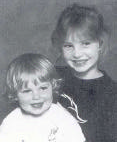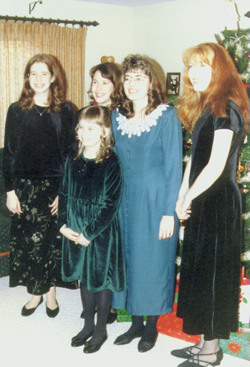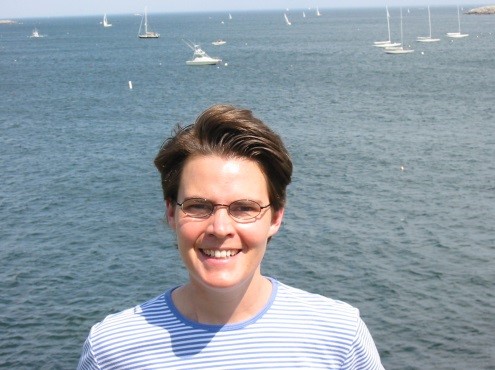
On September 14, 1999, when my four-year-old son Sean and I walked hand in hand through the doors of the Coffs Harbour Hospital, I had no inkling of what was about to happen. I suppose I should have known something was seriously wrong with Sean, given that I was a registered nurse and that he had been experiencing neurological symptoms for several weeks. Because he had been such a healthy and happy little boy until recent times, a brain tumor was the last thing I, or anyone else, including his local doctor expected. Expected or not, the following words uttered by an intern after an emergency CT scan had been attended changed my life “Sean has a lesion in his brain stem’,” the young doctor tearfully said. “It is probably a tumor.” And it was–a great big golf ball of a thing that was never definitively diagnosed.
Sean’s low-grade pontine astrocytoma was such an aggressive cancer that it took him from us within four months. Sean’s so-called brain stem lesion didn’t stop growing just because he was anesthetized that sunny spring day for a four hundred mile air ambulance flight southwards from our beachside home to Sydney. Intravenous and then naso-gastric tube dexamethasone slowed things down but didn’t reverse his fate. Sean never walked with ease again. He never ate or talked properly again. The initial medical free-for-all so damaged his personality it would be weeks before he volunteered to hold my hand and weeks before he rediscovered his smile.
After several days of non-invasive tests, a brain biopsy, and lots of frustrating waiting around in the Children’s Hospital at Westmead, Sydney, radiotherapy was commenced. Radiation did reverse a great many of Sean’s symptoms but ever so slowly and not until he suffered a stroke. It was this stroke that caused Sean’s left-sided paralysis, which affected his rehabilitation, the most.
Being the recipient of terrible information over and over again is like being violently pummeled to within an inch of your physical and emotional life. The parents of brain tumor children receive such information on a daily basis, sometimes several times a day. My wife Jane and I learned to take on board such news with equanimity. What right had we to express pain and sadness publicly, especially in front of Sean, we asked ourselves, when our son stoically suffered assaults to his body on a daily basis without even understanding why. “The doctors caused the lump in my head,” he finally told me not long before he died.
Because of his age Sean had all thirty radiotherapy treatments under a general anesthetic. Because of the affect the tumor had on his swallowing and respiratory functions, he endured an endotracheal tube and remained in the otherworldly intensive care unit at Westmead for several weeks. Because of the endotracheal tube, he suffered whole-body spasms whenever suction tubes entered his trachea several times each day to remove choking secretions.
While he was hospitalized, Jane and I spent all our waking hours and then some with Sean. We smiled and laughed. We read to him. We watched TV with him. We washed and massaged him. It was only in those few hours between midnight and dawn that we allowed grief full reign. Then we cried and moaned and prayed and called out “Why?” It was only away from Sean that we (me mostly) updated friends and family with grim news. With our ten-year-old daughter Sophie still hundreds of miles away, it was me who was forced to stumblingly explain to her by phone that Sean was going to die.

Jane and I became different people within ourselves and to each other. By day one thing, by night another. Loving more and hating more (Sean’s tumor, bad news, even God), by degrees. Jane became the chief caregiver, the nurturer. I became the provider, the one who spoke to doctors, who shopped and paid bills. We discovered the intended and true roles of men and women.
Eventually, with the help of his wonderful doctors, nurses and technicians, Sean began to get better. By the time he was ready to go home to Woolgoolga he was eating mush, moving all limbs a little and saying a few words. Once home, he improved even more. Soon he could walk/limp with a walker, pat his dog, read his train books, eat most solids, and even convey his philosophical ideas with ever longer, smile-inducing sentences. They were good times, those between times. We, Jane and I, and perhaps Sean knew what was coming but we put it to one side. We went to the beach, we swam in the town pool, and we watched videos together. We even planned a holiday.
In the days leading up to Christmas 1999, Sean began to complain, as before, of leg weakness. Jane and I avoided speaking of this ominous shadow for a time. We had to act when the leg weakness became scream-inducing pain.
Sean woke on Christmas Day unable to walk. He ignored his new toys, choosing to cry in pain instead. We aborted planned festivities and spent the day in Coffs Harbour Hospital. “Sean’s symptoms are neurological,” we were told eventually. We knew they were but that didn’t soften the blow.

We tried to embark on a curtailed holiday but it didn’t work. By the dawn of the new millennium, we were in Westmead again. This time the MRI told of secondary deposits everywhere: meningeal seeding, radiation growths, and spinal metastases. The new tumor at the base of Sean’s spine was responsible for his pain and lower limb paralysis. Jane and I found it hard to recover from this attack on our emotions. For Sean we had to. For a few days we did.
But still he died. Even after all he and we and they did, nothing can stop a primary brain stem tumor in a child. Nothing. And nothing did. Sean died at home on January 13, 2000, just into the new century with me injecting palliative doses of morphine. He missed it, this century, just as he is missing everything in his life.
Our grief began the day of Sean’s diagnosis. It went into overdrive after he died. I can’t explain how bad it was, and how bad it is for us. I wrote a whole book about our before and after lives, and I still cannot explain grief satisfactorily. All I can tell you is that grief is life changing and all encompassing. But it can be harnessed.
I began writing within days of Sean’s death. I didn’t stop until “Can I Take My Panda Daddy?” was published some five years later. I have never completely understood my motives for becoming an author at the expense of my son’s death. Partly, I know, I did it for love. But there were other reasons. Just as Jane hid her emotions away and began planting flowers so there would always be blooms for Sean’s grave, I transferred my parental duties to pens and keyboards. I became a writer out of a desire to tell the world about Sean and of his and our journey, but also to continue the fatherly role I began on September 4, 1995 when our much-loved bundle of joy was born. Later, the more I wrote and tearfully rewrote, the more I realized our story could benefit others–other parents and those in the caring professions, for example.
Much later, I realized my words meant that Sean would not only live on but that he could make an impact on the world beyond what his short life and early death, however tragic, did.
I suffer still from grief. Recently our little boy, Sophie’s brother, should have turned ten. For some reason this missed birthday affected me more than most previous ones had. Perhaps the double figures, the pre-teen number, subconsciously implied he was gone for good. I don’t know. Whatever the case, I know I miss my beautiful boy now more than I would the sun if it ceased to shine and I know, for that reason alone, I would not wish a brain stem glioma on anyone.
Written by Greg Crooks, Sean’s dad, author of, ‘Can I Take My Panda Daddy?’
This story was written for the Childhood Brain Tumor Foundation, Germantown, Maryland.

 A Tribute to Emily Mau
A Tribute to Emily Mau